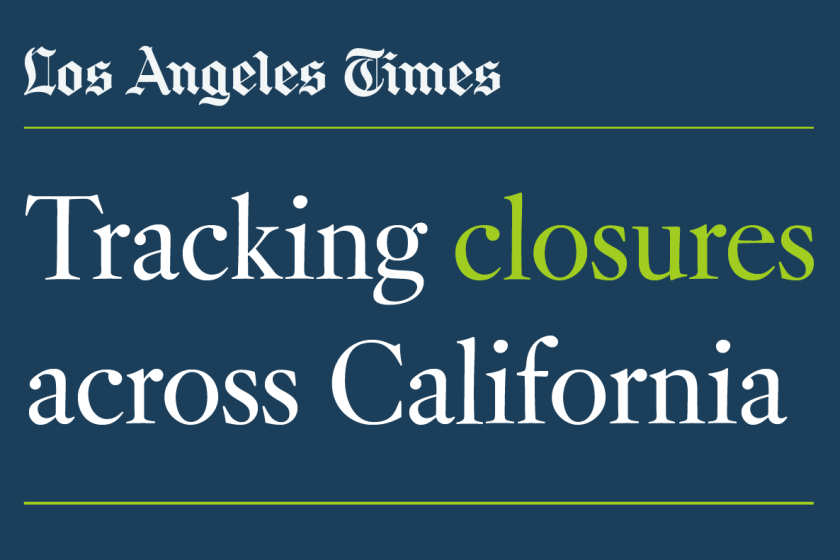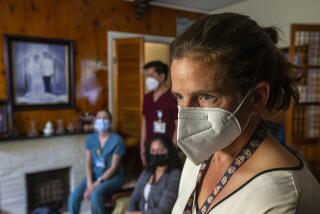COVID-19 crisis improves in Northern California, but L.A. County braces for more

- Share via
SAN FRANCISCO — As parts of Northern California began to see the first guarded signs of progress Tuesday in the battle against the winter coronavirus surge, communities in hard-hit Southern California were bracing for more cases to swarm hospitals already overwhelmed as COVID-19 continues to rise.
The post-Christmas surge is still slamming Los Angeles and surrounding counties. The spread is increasing again as people infected during holiday events test positive. Officials expect that will lead to more hospitalizations, but how much remains a critical question because medical infrastructure is already at the breaking point.
Any new spike in infections, officials warn, will trigger a resulting wave of new patients requiring professional care — creating an unsustainable strain on already overtaxed hospitals and intensive care units.
On Tuesday, a tally of local health jurisdictions found 318 deaths reported in L.A. County, tying the record single-day high of deaths recorded on Friday.
Daily coronavirus cases are also increasing. On Tuesday, 14,134 new coronavirus cases were recorded in L.A. County. That pushed the county’s average to more than 15,000 cases a day over the past week, one of the worst daily averages recorded in L.A. County and a warning sign of a future surge of hospitalizations.
Officials had forecast that averaging 15,000 cases a day would likely be a precursor to an even worse surge in hospitalizations. So far, that has not materialized, but officials expect that could soon change.
But to the north, the news was not quite as dire.
Gov. Gavin Newsom announced Tuesday that the state was lifting its stay-at-home order for Greater Sacramento effective immediately, making the region the first to emerge from the restrictions on businesses and activities imposed in hopes of blunting the coronavirus surge.
The counties included in the region — Alpine, Amador, Butte, Colusa, El Dorado, Nevada, Placer, Plumas, Sacramento, Sierra, Sutter, Yolo and Yuba — will return to the state’s color-coded tier framework that determines how widely commercial and public spaces can reopen.
“California remains in its most intense surge to date,” Newsom said in a brief video message announcing the move. “But there are some good things to report. We’re starting to see some stabilization both in ICUs [and] in our positivity rate. We’re also starting to see the rate of growth for hospitalizations beginning to decline.”
As of Tuesday, Greater Sacramento had more than 9% of its ICU beds available, and was projected to have an available capacity of at least 15% four weeks from now — the criteria to exit the stay-at-home order. The move will permit counties to allow for the reopening of hair salons and barbershops in a limited capacity and allow other businesses, including restaurants, to resume some outdoor operations.
To contain the spread of COVID-19, parks, restaurants and stores are slowly reopening.
San Francisco also had encouraging data. Dr. Grant Colfax, San Francisco’s director of public health, said that while coronavirus cases rose by 70% after Thanksgiving, they rose only by 28% since Christmas and New Year’s.
“The rate of increase is not as severe as after Thanksgiving,” Mayor London Breed said at a media briefing Tuesday. “This is some good news.”
But the Bay Area continues with the stay-at-home rules because available intensive care unit capacity across the region is still critical — at less than 5%.
For instance, in Santa Clara County, conditions in hospitals are still strained. The morgues at three hospitals are at capacity and four others are near capacity, said Dr. Ahmad Kamal, the county health preparedness director.
In fact, there are so many COVID-19 patients in Silicon Valley’s hospitals, they have effectively squeezed out non-COVID patients from the ICU, Kamal said.
“This means that either their care is being deferred or that they are being taken care of at a level of care that is less than one would ideally want,” Kamal said. The consequences of deferring important medical care will become apparent in the months and years to come, “because these people are going to get sicker and their needs are going to increase.”
But on the positive side, while hospitalizations are still worsening, the increase is “not as fast” as it was, Kamal said.
Statewide, officials said there is some initial evidence the Christmas spike has not been as bad as the Thanksgiving spike.
The number of coronavirus-positive patients hospitalized throughout California has plateaued at just under 22,000, and new COVID-19 admissions have also declined — from roughly 3,500 new hospitalized patients a day last week to between 2,500 and 2,600, according to Dr. Mark Ghaly, California’s health and human services secretary.
While the number of cases can be skewed by how many people are being tested, and when those results are being reported, he said Tuesday that “hospital numbers don’t lie.”
“People come to the hospital, they get the care that they need when they need it because they’re that sick,” he said during a briefing. “And so, to see a reduction in our hospital numbers in the last week to 10 days, in terms of the rate of rise, I think is a very encouraging sign. But we’re not out of the woods. We know that there’s still a lot of COVID in our communities, that people can easily transmit it.”
That’s also not to say a decline is imminent, Ghaly said: “We are preparing and anticipate that some increase in hospitalizations will come in the middle of the month.”
“We’re just hopeful it’s not as significant as we expected and, certainly, not as significant as it would have been had we not seen these reductions in transmission, in part because of that regional stay-at-home order,” he said, referring to the additional restrictions on businesses and activities imposed on specified swaths of the state when the available capacity in their ICUs falls below 15%.
California on Tuesday posted high single-day counts for coronavirus cases and deaths — well above the daily average. A daily survey conducted by The Times found 53,260 coronavirus cases — the sixth-highest single day tally — and 678 deaths reported Tuesday. The death tally was the second-highest of any single day in the pandemic, eclipsed only by the count on Friday, when 685 fatalities were recorded.
Tuesday marked the first time that California surpassed the milestone of recording an average of more than 500 COVID-19 deaths a day over a weekly period. A Times analysis found that California is now averaging 520 deaths a day — roughly equivalent to a Californian dying every three minutes.
In Southern California, officials warn the worst may still be ahead. Southern California and the San Joaquin Valley were still at 0% available ICU capacity as of Tuesday.
Besides Los Angeles County, the Inland Empire has been battered by the surge, with hospitals overflowing with patients. Even coastal counties to the northwest — San Luis Obispo, Ventura and Santa Barbara — have seen alarming increases in cases over the last week.
L.A. County has recorded a cumulative total of 947,035 coronavirus cases as of Tuesday, and 12,706 cumulative COVID-19 deaths. That’s more than 40% of the 31,000 cumulative COVID-19 deaths in California, even though L.A. County makes up about one-quarter of the state’s population.
More than 2,300 people countywide have died from COVID-19 since New Year’s Day, and L.A. County has averaged about 231 COVID-19 deaths daily over the last week, a rate higher than at any other point during the pandemic.
Though the number of COVID-19 patients hospitalized countywide has stabilized, at just shy of 8,000, the sustained increase has forced some county hospitals to set up beds in hallways and even in gift shops and keep some patients waiting in ambulances for as many as 17 hours before room in the emergency room opens up.
Hospital morgues are so overcrowded in L.A. County that the National Guard has been helping county workers store bodies at the coroner’s office, where refrigerated containers have been brought in to quadruple capacity, until funeral homes and mortuaries can accommodate the backlog. Some hospitals have had to declare internal disasters and temporarily shut their doors to all incoming ambulances because of staffing problems or dysfunctional oxygen supply systems, essential for COVID-19 patients gasping for air.
L.A. is seeing “signs of this deadly surge continuing, even though the numbers of hospitalized patients across the county have stabilized for now,” said Dr. Christina Ghaly, the L.A. County health services director, on Monday.
“We’re watching the data very carefully over the next couple of days, as this is the time when we would anticipate beginning to see the surge in patients from the recent Christmas and New Year’s holidays,” she said.
Lin and Dolan reported from San Francisco, Money from Long Beach. Times staff writers Sandhya Kambhampati, Swetha Kannan, Ryan Menezes and Andrea Roberson contributed to this report.
More to Read
Sign up for Essential California
The most important California stories and recommendations in your inbox every morning.
You may occasionally receive promotional content from the Los Angeles Times.














